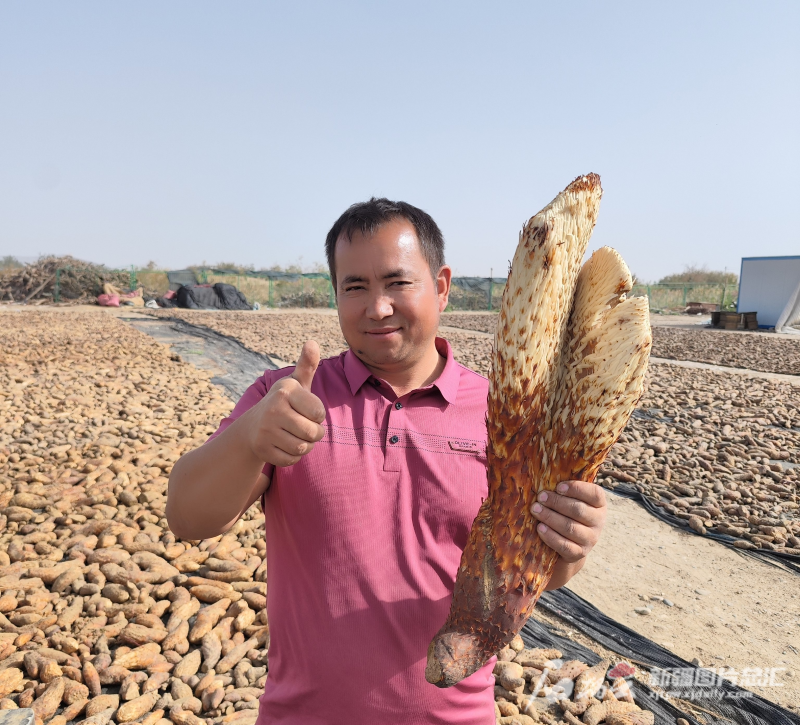Shiliuyun-Xinjinag Daily (Reporter Li Jiani, Correspondent Huang Zhen) news: Early in the morning of November 19, 2023, Yusup Ahat was busy packing the dried Cistanche deserticola into baskets and waiting for the buyer to load them onto the trucks. When most of the villagers around him ended their farming in winter, he is still busy.

Photo shows Yusup Ahat holds the dried Cistanche deserticola in Kunyu City, northwest China’s Xinjiang Uygur Autonomous Region. (Photo provided by Yusup Ahat)
"With a minimum harvest of 300kg of fresh Cistanche deserticola per mu (about 0.07 hectares), the annual income from 500 mu (about 33.33 hectares) is very substantial," Yusup said.
Yusup, 35 years old, living in Kunyu City, northwest China’s Xinjiang Uygur Autonomous Region, has more than ten years of experience in planting Cistanche deserticola. From planting less than one mu (about 0.07 hectares) of land at first to planting more than 1000 mu (about 66.67 hectares) in partnership with others this year, he has developed a high-yielding mode for artificially planting Cistanche deserticola through years of exploration..
Before planting Cistanche deserticola, Yusupu had planted cotton, corn and other crops. However, due to the strong wind and sand, soil salinity and other reasons, his annual income was lower than expected. How to make good use of desert resources? Is it possible to grow anything at the edge of the desert? He began to think about planting something different.
Remembering that his father had said that wild Cistanche deserticola in the desert had high medicinal value, he decided to plant them artificially. Unlike his previous attempts, he started with planting on a small scale. The following May, he was encouraged by the fact that most of the Cistanche deserticola had blossomed and fruited, leading him to expand the planting area.
As a parasitic plant, Cistanche deserticola mostly grows under trees and shrubs such as Haloxylon ammodendron and Tamarix ramosissima. But for two consecutive years, using the same planting technology, the yield of Cistanche deserticola under Haloxylon ammodendron and Tamarix ramosissima was not the same. Yusup was very confused and began to adjust the planting method from the third year. Eventually, he found that as the host was different, the depth of sowing Cistanche deserticola seeds also needed to be adjusted appropriately.
After solving the problem of using different planting methods for different hosts, Yusup began to concentrate on improving production. In his view, finding the right method will not only benefit him, but also provide new ideas for company workers and the public to start their own businesses.
From seedlings to harvesting, Yusup has summarized a set of tips and tricks. For example, unlike other areas, the annual harvest period of Cistanche deserticola in 224 regiments in Kunyu City lasts nearly four months. That is because Yusup insists on harvesting only ripe Cistanche deserticola, instead of those that fail to meet this standard. He strictly controls the quality of the Cistanche deserticola and improves the yield by harvesting the Cistanche deserticola many times a year to ensure that the Cistanche deserticola is qualified and mature each time.
With the development of new media, Yusup decided to use short videos to promote Cistanche deserticola, and signed up for an account to share Cistanche deserticola planting and harvesting from time to time online. Now he has more than 60,000 followers, and more and more people know him for planting Cistanche deserticola on the edge of the desert.
Yusup's enthusiasm and efforts in the cultivation of Cistanche deserticola have paid off. Many businessmen have traveled thousands of miles to the 224 regiment to buy Cistanche deserticola. From cultivating Cistanche deserticola alone till now, Yusup has led dozens of workers to get involved in the planting process and realize the dream of digging "gold" in the desert.
Yusup said that planting Cistanche deserticola is a cause worth struggling for, and he hopes that he can benefit from it together with more people and live a better life.
(A written permission shall be obtained for reprinting, excerpting, copying and mirroring of the contents published on this website. Unauthorized aforementioned act shall be deemed an infringement, of which the actor shall be held accountable under the law.)









